What is a pocket chart?
A pocket chart is a clever way to display letters, words, sentences as well as pictures and other items. It contains pockets where the cards can be placed and it’s an easy way to make a portable and interactive display.
How can I get one?
They seem to be fairly common in many schools and among teachers, but to be honest it doesn’t seem to be so popular here in Spain. I saw one for the first time last year when I received a second-hand one as a present. I find them extremely useful for any class, any subject and a must-have tool for a language class and I’m surprised that EFL books don’t come with one in their course packs.
Basically you can either buy one or make your own by laminating a big piece of colored cardboard. Then, stick strips of clear plastic from one side to the other, making the pockets with them.
How can I use it?
It has hundreds of possibilities in the English class. From being a portable word display to becoming an interactive board for children to learn about phonics, letters, words and so on.
Some activities:
- Alphabet chart (Letter level)
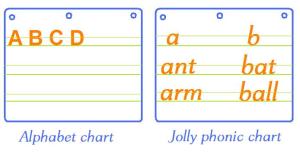 Have one or more students place the alphabet cards in order. This activity can be done while singing the alphabet song or listening to alphabet stories such as: ABC, by Dr Seuss or Chicka, chicka, boom, boom, by Bill Martin jr.
Have one or more students place the alphabet cards in order. This activity can be done while singing the alphabet song or listening to alphabet stories such as: ABC, by Dr Seuss or Chicka, chicka, boom, boom, by Bill Martin jr.
Place some letters on top. Students then have to place words underneath starting with that letter.
Use it with Jolly Phonics. Place the sound and the words in the jolly phonic jingle.
Have students match two pictures. Ex. color and animal.
Have students match a picture and the word. Ex. frog and picture of a frog.
Reading comprehension: match sentence and picture. Ex. The bird is red and the picture of the bird.
- Sequencing (sentence and text level)
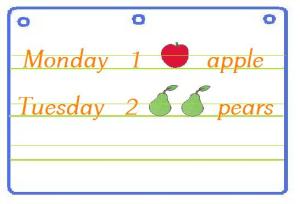 Start the session by placing the date and the weather cards at the top of the chart.
Start the session by placing the date and the weather cards at the top of the chart.
You can sequence: months, days of the week, colors of the rainbow and so on.
You can sequence a story. Ex. brown bear, red bird, yellow duck and so on (from Brown bear, brown bear, what do you see?, Bill Martin jr.)
Ex. Monday 1 apple, Tuesday 2 pears and so on (from The very hungry caterpillar, Eric Carle)
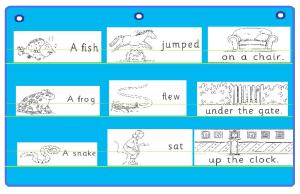 Writing practise: Have three piles of cards featuring nouns, verbs and complements. Children pick one card from each pile and put them in order to form a sentence. This exercise can be taken to the next level where several sentences are displayed and children write a Nonsense book. You can find this activity in The children’s busy book. This book is written by a Canadian mother and is full of activities you can use at home with your children and at school with your students. I have tried this activity many times, with children of different ages and different backgrounds and they always love to create their nonsense book and are eager to show them to classmates and parents.
Writing practise: Have three piles of cards featuring nouns, verbs and complements. Children pick one card from each pile and put them in order to form a sentence. This exercise can be taken to the next level where several sentences are displayed and children write a Nonsense book. You can find this activity in The children’s busy book. This book is written by a Canadian mother and is full of activities you can use at home with your children and at school with your students. I have tried this activity many times, with children of different ages and different backgrounds and they always love to create their nonsense book and are eager to show them to classmates and parents.
These cards can be found in Developing literacy: sentence level Year R, A & C Black.
- Spelling
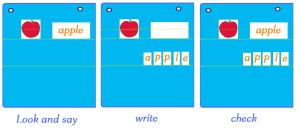 Following the “look, say, write, check” technique you can practise spelling with your whole class, individual students or groups. Just place the word you want them to spell and the picture in the pocket chart. Students look at the picture and word, say the word, turn the card backwards, choose the letters and write the word, then turn the word back and check (correct if necessary).
Following the “look, say, write, check” technique you can practise spelling with your whole class, individual students or groups. Just place the word you want them to spell and the picture in the pocket chart. Students look at the picture and word, say the word, turn the card backwards, choose the letters and write the word, then turn the word back and check (correct if necessary).
Place one picture in the pocket chart. One student says the name and looks for the letters to form the word. The rest of the students can write 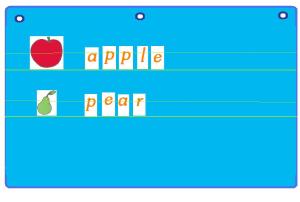 it down in their notebooks.
it down in their notebooks.
- Games
Bingo. Each student has a bingo board with nine pictures from a topic. The teacher or student has a bag with all the cards from that vocabulary set (more than nine of them), picks a card, says the name and places it in the pocket chart for everybody to see it. The cards could be picture or words.
Why should you use a pocket chart in your English class?
Many of these activities could be done using a white board, so why use a pocket chart? Well, there are two clear advantages: time and interaction.
Pocket charts save time. Once the cards are made and laminated, they can be used many times, with many classes. The pocket chart can be hung in a second and the activities can be performed right away. You can change from one activity to the next just by picking the next set of cards, all this without your back turned to the kids while writing.
But probably the most important reason is that pocket charts are an interactive way to learn English. Children need to use all their senses. They need to move and manipulate things. Letter cards are perfect to teach spelling and children will feel like playing when forming words with them.
Do you use traditional literacy tools in your EFL class? Do you know any other literacy tools that can be used in EFL classes?
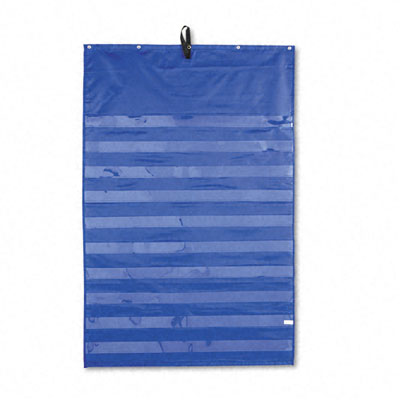
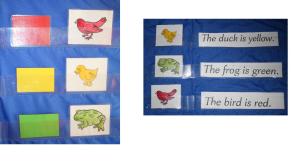
Your blog posts are so interesting !!! Please be my Guest Blogger at
http://www.eflpreschoolteachers.blogspot.com
and join me at my Facebook Group: ESL/EFL Preschool Teachers.
Rosa Amelia